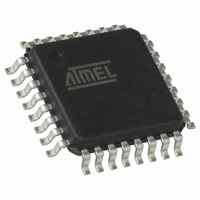QT60168C-ASG Atmel, QT60168C-ASG Datasheet - Page 41

QT60168C-ASG
Manufacturer Part Number
QT60168C-ASG
Description
IC TOUCH SENSOR 16KEY 32TQFP
Manufacturer
Atmel
Series
QMatrix™, QProx™r
Type
Capacitiver
Specifications of QT60168C-ASG
Number Of Inputs/keys
16 Key
Resolution (bits)
9, 11 b
Data Interface
Serial, SPI™
Voltage - Supply
3 V ~ 5 V
Current - Supply
25mA
Operating Temperature
-40°C ~ 105°C
Mounting Type
Surface Mount
Package / Case
32-TQFP, 32-VQFP
Output Type
*
Interface
*
Input Type
*
For Use With
427-1087 - BOARD EVAL QT60248-AS QMATRIX
Lead Free Status / RoHS Status
Lead free / RoHS Compliant
Available stocks
Company
Part Number
Manufacturer
Quantity
Price
Company:
Part Number:
QT60168C-ASG
Manufacturer:
Atmel
Quantity:
5 323
4.2.5
4.2.6
4.2.7
4.2.8
Touch Sensors Design Guide
Illumination Effects
Floating Conductive Items
Conductive Paints
Transparent Y Electrodes
With the planar construction of mutual-capacitance type electrodes it is fine to make holes in the X
portion of the electrode to allow light to shine though, much as described in
Effects” on page
Try not to remove too much of the X area or you risk making a dead spot in the key.
Transparent electrode materials also work well with this type of sensor if you take care to meet RC time
constant constraints (see
Mutual-capacitance type sensors are much less sensitive to floating metal as self-capacitance types.
The reason for this is that the measured field is localized between X and Y. However, it is still good
practice to avoid such risks, as described in
The considerations for the use of conductive paints described in
page 3-7
Transparent Y electrodes can end up with significant series resistance if made from materials like ITO or
Orgacon. This can be a problem due to excessive RC delay. Consider using printed silver or carbon
tracks or copper traces to add more than one connection point, if possible, to lower the resistance (see
Figure 4-9 on page
required transparent area, of course) is possible.
Figure 4-9.
apply.
Lowering Resistance with Extra Silver, Carbon or Copper Traces
3-5. The rules for LEDs are described in
4-9). Selective use of silver or copper over the top of the electrode (outside the
Section 2.1 “Charge Transfer” on page
R
total
= 5 x
s W
R
Digital Multimeter
Digital Multimeter
/sq
total
= 20 x
Section 3.2.6 “Floating Conductive Items” on page
s W
/sq
Mutual-capacitance Zero-dimensional Sensors
Section 2.4 “Nearby LEDs” on page
2-1).
Section 3.2.7 “Conductive Paints” on
Extra connection
reduces worst
resistance by 4 times
Section 3.2.5 “Illumination
Silver,
Carbon
or Copper
10620D–AT42–04/09
2-7.
3-6.
4-9















